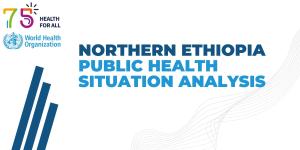Northern Ethiopia - Public Health Situation Analysis (PHSA), 25 August 2023
Conflict, internal displacement, socio-economic hardships, collapse of public services (education, health, etc.), and natural hazards, including disease outbreaks, recurrent floods, locust outbreaks, and consecutive droughts, have increased the humanitarian needs in Ethiopia in 2023.
The end of 2022 brought about peace and improved access in northern Ethiopia (Afar, Amhara and Tigray) with the signing of the cessation of hostilities agreement (COHA). The conflict, which lasted from November 2020 to November 2022, left 88% of the population in need by mid-2022.1 The Humanitarian Response Plan for 2023 requires 4.16 billion USD to target 20.1 million people. To address urgent health needs, the Health Cluster requires 303 million USD to target 9.8 million people. As a result, humanitarian needs stemming from the two-year conflict are still high, and increased support is required to facilitate returns and scale-up recovery efforts.
Reports indicate that there are 3.14 million IDPs and around 1.9 million returnees across Ethiopia. Currently in Tigray, there are over 1 million people that remain displaced with an estimated 700,000 previously returning home spontaneously since the end of the conflict. 4 However, in May 2023, facilitated returns have been paused due to gaps in available support.5 Regionally, the heavy fighting in Sudan has resulted in 844 574 individuals having moved into neighbouring countries, including 69 946 arrivals to Ethiopia (as of July 23rd, 2023).
Across Ethiopia, high food insecurity persists with over 20 million people in urgent need of food assistance and agriculture support, an increase of about 150% over the last 5 years. An estimated 8.8 million people are in need of food assistance in the Afar, Amhara and Tigray region, particularly in zones that were affected by the conflict and drought In Tigray, a pause in food aid in early 2023 has led to an increased number of people resorting to negative coping mechanisms such as consuming less food, child marriage, and family separation, are on the rise, particularly among these regions’ pastoralist communities. As a result, the food security situation in Tigray is expected to worsen.
The prolonged drought in the Horn of Africa has also left 23.4 million people acutely food insecure in 2023, including 13 million people in Ethiopia (including northern regions). Ethiopia is among seven countries globally considered to be at the highest risk of severe humanitarian impacts caused or worsened by El Niño. Since the beginning of March 2023, heavy rainfall has affected several regions in Ethiopia. Repeated shocks have eroded the coping capacities of households, particularly in Tigray region, and this may reduce how communities can respond to the potential impacts of El Niño.
There are currently four outbreaks impacting Ethiopia, namely cholera, measles, malaria, and dengue. Limited access to health services, medical supplies, WASH services, and trained health workers remain to be gaps in responding to the different disease outbreaks that affect the country. The Health Cluster also reports the perceived return to normalcy in Tigray after the signing of peace agreement is a challenge as needs remain high and the health system has not yet recovered. Poor WASH facilities also contribute to the risk of malaria/dengue and cholera outbreaks (poor access to good quality drinking water, low latrine coverage, open defecation, and breeding sites for mosquitoes).18 A total of 60% to 80% of communicable diseases are attributed to limited access to safe water and inadequate sanitation and hygiene services.
Regarding access, the situation in Tigray has shown improvements in early 2023 with the security situation calm in most areas. The peace agreement has also led to improved access to commercial services, transporters, and airlines, allowing humanitarian partners to access some areas with their own trucks. More broadly, woredas along the Eritrea-Ethiopia border, north eastern Amhara, and Western zone of Tigray recorded the main humanitarian access constraints. However, amid an insufficient humanitarian response, more comprehensive reconstruction, rehabilitation, and recovery assistance is urgently required.
Finally, both needs and access challenges are now further exacerbated in northern Ethiopia because of on-going clashes in Amhara. On 4 August 2023, a six-month state of emergency was declared in Amhara following intense clashes between regional special forces, militia allies, and the Ethiopian National Defence Forces. The clashes followed a series of protests since 6 April, when the Federal Government announced the need to disband regional forces. As of August 22nd, the situation in the region has largely stabilized following weeks of hostilities, which had even occurred in major town hubs. The recent hostilities are most likely to worsen the hardship of civilians, especially with the limited humanitarian operations that came to a halt following the insecurity. Those affected are moving to safer areas in the region, although the conflict and state of emergency declaration have been constraining movements.
Contacts
Dr ABOK, Patrick
EPR Team Lead
abokp [at] who.int (abokp[at]who[dot]int)
Dr Abiy Girmay
Epi-surveillance Focal
girmaya [at] who.int (girmaya[at]who[dot]int)
